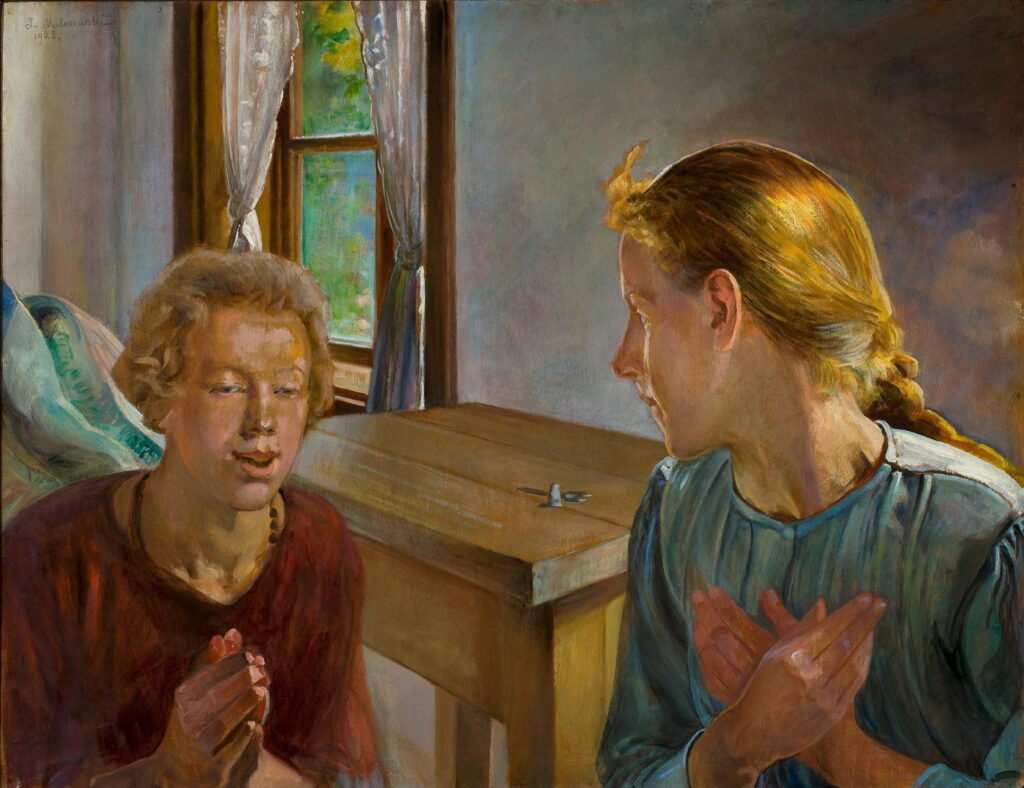Reading Visual Art: 192 Curtains as a device

In addition to their use for concealment and revelation in paintings, curtains serve other purposes, often as a visual device, or in their everyday roles. They have been widely used through history to provide privacy and separation for sleeping, classically in the four-poster bed.
Hieronymus Bosch (c 1450–1516), Death and the Miser (right wing of The Wayfarer triptych) (1500-10), oil on oak panel, 94.3 x 32.4 cm, The National Gallery of Art, Washington, DC. Wikimedia Commons.
The right wing of Hieronymus Bosch’s reconstructed Wayfarer triptych shows a frail and emaciated man in bed, being tended to by an angel, with a devil poised above him, and the figure of death coming in through the door. The scene is a barrel-vaulted bedroom which goes deep, and is furnished with a large bed with a canopy and side-curtains. At the foot of the bed is a large chest containing money and valuables. In the foreground, the bedroom ends in a pillar at each side, with a low wall joining them.
The figure of death is shown as a skull on a near-skeletal body and limbs, holding a long silver arrow in its right hand. That arrow points towards the man in bed. Peering over the canopy above the bed is a small devil who holds a lantern on a rod. More devils are seen under the chest, one holding up a document with a red seal on it. Another devil is looking over the frontmost low wall, by the garments laid on it.
Jean-Paul Laurens (1838–1921), The Death of Galeswintha (1906), oil on canvas, 65.5 x 85 cm, National Museum of Fine Arts, Buenos Aires, Argentina. Courtesy of National Museum of Fine Arts, via Wikimedia Commons.
Galswintha (540-568 CE), or Galeswintha, was the daughter of the Visigoth king of the Iberian Peninsula (Spain and Portugal), and sister of Brunhilda, Queen of Austrasia (Belgium across to Germany). She married King Chilperic I, the Merovingian ruler of Neustria (northern France), in 567. However, marriage didn’t suit Chilperic’s mistress Fredegund, who arranged for Galswintha to be strangled so she could marry the king. That murder caused her sister Brunhilda to make war for forty years against Chilperic, and his murder in 584, possibly by Fredegund.
Jean-Paul Laurens shows Galswintha lying, presumably dead, in a heavily built four-poster bed, its curtains partly drawn back. A young well-dressed woman (presumably Fredegund) views her from the foot of the bed. Fredegund is partly undressed, her right shoulder and much of her back bare, as if she too is just getting ready for bed. Just outside the room, on the other side of a drawn curtain, is a man, who looks in through a gap in that curtain. He is presumably King Chilperic waiting for his mistress to join him, now that he is a widower and free to marry her.
Antoine Wiertz (1806–1865), The Reader of Novels (1853), oil on canvas, dimensions not known, Le Musée Antoine Wiertz, Brussels. Wikimedia Commons.
Antoine Wiertz’s Reader of Novels from 1853 is perhaps his most curious painting. A shapely and completely naked woman lies on her back, a book held above her face, reading avidly. Her bed is in a small compartment, a large mirror hanging above her lower body and legs. Her clothing is hung on the foot of the bed, and a floral garland on the top of the mirror. Beside her on the bed are several other books, and the hand of a horned figure is reaching up to those books from below and behind a curtain.
This has all the elements of what later became the ‘problem picture’, a visual riddle which the viewer was invited to solve by building a narrative which fitted the various clues. It could just be dismissing the reading of novels by women as a morally dangerous activity, but it seems too elaborate for that. I wonder if the woman is part of a ‘live peep show’, and passing the time by reading, perhaps, or just a prostitute in her booth in a brothel, although the bed is too small to accommodate a partner. Whatever it meant, it was badly received when exhibited, and deemed pornographic.
Moritz Stifter (1857–1905), The New Dress (1889), oil on panel, 30.5 x 40 cm, location not known. Wikimedia Commons.
At first sight, Moritz Stifter’s The New Dress from 1889 shows a simple scene set in the dressmaker’s. Every face is smiling here, some perhaps a little vacuously, as an affluent young woman tries on a new dress, with its incredibly small waist. Look carefully, though, at the cameo views revealed by its open curtains that are attracting the attention of two of the staff in the background. In one there’s an adult and child apparently watching what can be glimpsed through the window to the right. There is a close-packed crowd who don’t appear to be happy, and perhaps express the artist’s disapproval of events taking place in the dressmaker’s.
Occasionally, the nature and state of curtains can add to the signs shown in the rest of the painting.
John Roddam Spencer Stanhope (1829–1908), Thoughts of the Past (1859), oil on canvas, 86.4 x 50.8 cm, The Tate Gallery (Presented by Mrs F. Evans 1918), London. © The Tate Gallery and Photographic Rights © Tate (2016), CC-BY-NC-ND 3.0 (Unported), http://www.tate.org.uk/art/artworks/stanhope-thoughts-of-the-past-n03338
Thoughts of the Past (1859) was the first of John Roddam Spencer Stanhope’s paintings to be exhibited at the Royal Academy (in 1859), and remains one of his best-known works. It shows a woman standing by a window that looks out onto the River Thames in London, and is a faithful depiction of the studio below that used by Dante Gabriel Rossetti at the time, at Chatham Place, London.
The woman and her surroundings contain rich clues as to her status: behind her, a gaudy cloak is hanging, with some white lace. The small dressing table is tatty and covered with cheap, garish jewellery and other items. Potted houseplants straggle up for light from the window, and at their foot is a man’s glove and walking stick. She is dressed for the bedroom, her long red hair let down. A short drop of cheap and dirty net curtain is strung across the lower section of the window.
She looks gaunt, her eyes tired and sunken, and stares in quiet sadness at the viewer. The view looks towards Waterloo Bridge, with the Strand embankment to the right, an area that was a popular haunt for prostitutes. Her thoughts are clearly of remorse at her shameful occupation, and her only means of redemption, that of drowning herself in the river.
George Bellows (1882–1925), Nude with Fan (1920), oil on canvas, 111.8 × 86.4 cm, North Carolina Museum of Art, Raleigh, NC. Wikimedia Commons.
Around 1920, George Bellows painted more figurative and portrait works, including this Nude with Fan. This wasn’t his first nude, but is remarkable for its richly-lit embedded cameo landscape with marked aerial perspective, that may have been intended to enhance depth. That view is framed by a pair of floral curtains and a blind.
Jacek Malczewski (1854–1929), Annunciation (1923), oil on plywood, 61 x 79 cm, Muzeum Narodowe w Warszawie, Warsaw, Poland. Wikimedia Commons.
In Jacek Malczewski’s account of the Annunciation, Mary (right) is a modern young woman, whose thimble and scissors rest on a bare wooden table behind. Gabriel is in the midst of breaking the news to her, his hands held together as he speaks. The window and curtains make clear that this is twentieth century Poland, not the Holy Land two millennia ago.
Johannes Vermeer (1632–1675), Girl reading a Letter at an Open Window (c 1658), oil on canvas, 83 × 64.5 cm, Gemäldegalerie Alte Meister, Staatliche Kunstsammlungen, Dresden, Germany. Wikimedia Commons.
Some of Jan Vermeer’s paintings feature heavy curtains in the foreground, drawn back to reveal his subject behind. Among those is his Girl reading a Letter at an Open Window (c 1658), where its railed curtain gives an air of intimacy, suggesting that the viewer is peeping past the curtain and gazing in at real and private life.
I end this collection with another trompe l’oeil, this time for a still life from the Dutch Golden Age.
Cornelis Norbertus Gysbrechts (fl 1657–1683), Trompe l’oeil. Board Partition with Letter Rack and Music Book (1668), oil on canvas, 123.5 x 107 cm, Statens Museum for Kunst (Den Kongelige Malerisamling), Copenhagen, Denmark. Wikimedia Commons.
At that time, painters such as Cornelis Norbertus Gysbrechts made their speciality the production of trompe l’oeil still lifes. A popular theme was the wall-mounted letter-rack, shown in his Board Partition with Letter Rack and Music Book (1668), with its carefully positioned curtain.



